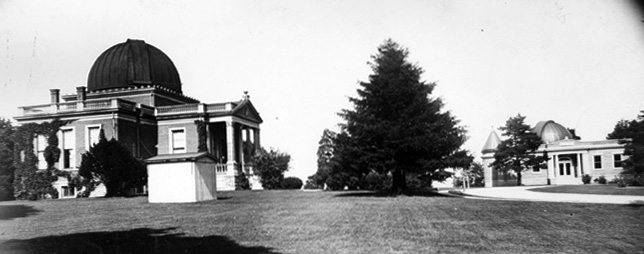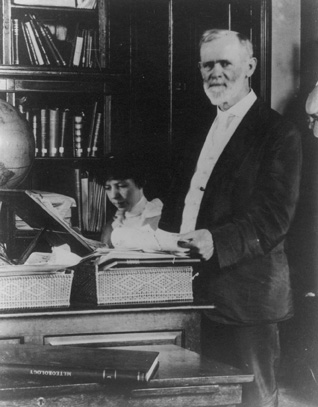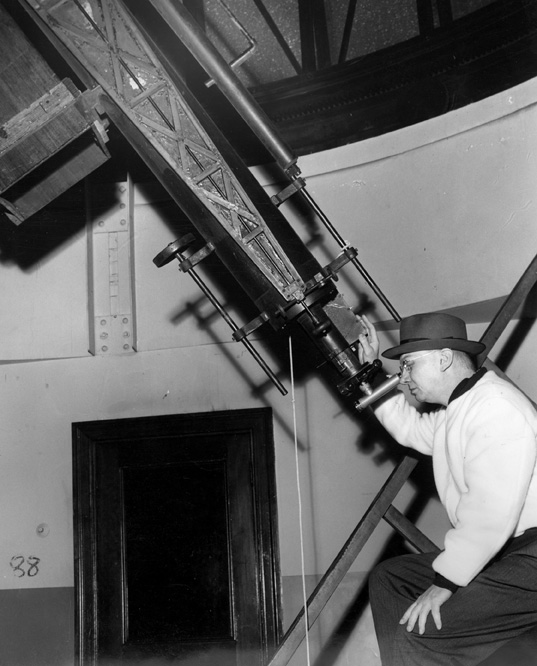The Cincinnati Observatory is a local historical treasure and holds what was once one of the world’s largest telescopes. Throughout its history, the observatory has served as a source of weather forecasts, official Cincinnati time, and a site of scientific discovery. It also has a long connection with the University of Cincinnati. The Archives and Rare Books Library holds many observatory records along with the papers of long-time director Paul Herget.
The history of the observatory abounds with interesting and peculiar facts. The Cincinnati Observatory was founded in 1842 by Ormsby McKnight Mitchel, a professor of engineering and mathematics at Cincinnati College, which was a predecessor of the University of Cincinnati. A native of Morganfield, Kentucky and a West Point graduate, Mitchel generated interest in astronomy and an observatory in Cincinnati, and was among the founding members of the Cincinnati Astronomical Society. Mitchel traveled to Munich to procure a lens for the telescope and then oversaw the construction of the observatory on Mt. Ida. If you’ve never heard of Mt. Ida, there is a reason. Mitchel, with the assistance of several prominent Cincinnatians, convinced seventy-five year old former president John Quincy Adams to travel to Cincinnati to lay the cornerstone for the observatory in November of 1843. After which, Mt. Ida was renamed Mt. Adams. In an interesting twist, Mitchel later had something named for him too. Ft. Mitchell in Northern Kentucky was named for Mitchel (although they did spell his name wrong).
Under Mitchel’s direction, the observatory was very productive. The observatory published the Sidereal Message, a magazine about astronomy. Observations were made double stars and the observatory began recording time. These records were eventually used to establish standard time for the City of Cincinnati.
Mitchel left Cincinnati in 1860 for the Dudley Observatory in Albany, New York, and met a tragic end. He died of yellow fever while serving in the Army during the Civil War. The observatory remained closed until Cleveland Abbe was appointed director in 1868, and brought about another nationally significant connection to the observatory. Abbe used the observatory for weather prediction, and on September 1, 1869 began issuing a daily weather bulletin. Abbe’s work proved so influential that in 1870, he left the observatory to help establish the National Weather Bureau.
In 1871, the University of Cincinnati took possession of the Cincinnati Observatory and moved the observatory to a new location the Mt. Lookout area where it still stands today. A series of successful directors served the observatory throughout the late 19th and 20th centuries including UC professor Paul Herget. Herget was a 1931 graduate of the University of Cincinnati, who began working as an assistant at the observatory while studying for his Ph.D. Herget was appointed director of the Cincinnati Observatory in 1943 and instituted the use of computer tabulation at the observatory. In 1947, he began directing the Minor Planet Center of the International Astronomical Union.
In 1977, Herget retired and the observatory lost a major source of funding when the University of Cincinnati became part of the state university system. The observatory closed for a period of time, and then in 1979, became part of the Physics Department at the University of Cincinnati. In 1997, the Cincinnati Observatory Center was established, and in 1999 was issued a long-term lease to the observatory by UC.
If you’re interested in learning about the Cincinnati Observatory and its history, you’re in luck. The Cincinnati Observatory offers tours, classes, and opportunities to look through the telescopes to the general public on a regular basis. Check their website for the latest events or call them directly at (513) 321-5186. If you’re interested in doing your own research, see the finding aids for the Paul Herget papers and the Cincinnati Observatory records for more information on the materials in these collections and then visit the Archives and Rare Books Library to see them yourself.



